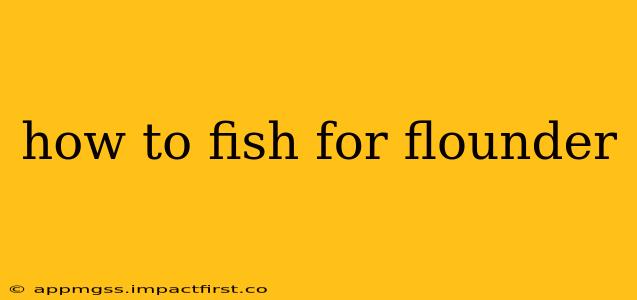Flounder fishing offers a unique and rewarding experience for anglers of all skill levels. These flatfish, masters of camouflage, require a bit of strategy and technique to catch successfully. This comprehensive guide will cover everything from choosing the right gear to mastering effective fishing techniques, helping you land your next prize.
What is the best bait for flounder fishing?
The best bait for flounder fishing depends heavily on the location and time of year. However, some consistently effective options include:
- Live bait: This is often considered the top choice. Small live fish like mullet, pilchards, or even small croaker are excellent choices. The natural movement of live bait is incredibly alluring to flounder.
- Cut bait: If live bait isn't available, cut bait works well. Pieces of squid, menhaden, or other oily fish are excellent choices. The scent trails attract flounder from a distance.
- Artificial lures: Soft plastic lures, jigs, and even spoons can be highly effective, particularly for targeting specific areas. Experiment with different colors and styles to find what works best in your location.
Remember to consider the size of your bait relative to the size of the flounder you're targeting. Too small, and you'll attract smaller fish; too large, and you might scare them away.
What kind of rod and reel should I use for flounder fishing?
Choosing the right rod and reel is crucial for a successful flounder fishing trip. You need a setup that can handle the weight of your bait, offer good sensitivity for detecting bites, and allow for efficient hook setting.
- Rod: A medium-light to medium power spinning rod, ranging from 6.5 to 7.5 feet in length, is generally ideal. The length provides sufficient casting distance and control. Look for a rod with a sensitive tip for detecting subtle bites.
- Reel: A spinning reel sized 2500-4000 will be perfect. Choose a reel with a smooth drag system to prevent line breakage when fighting a strong flounder.
What is the best time of day to fish for flounder?
Flounder are ambush predators, often lying in wait for their prey. Their activity levels can vary depending on several factors, including tide, water temperature, and sunlight. However, generally speaking, the best times to fish for flounder are:
- Dawn and dusk: These periods offer lower light levels, making flounder more active as they are less likely to be seen by prey.
- During incoming and outgoing tides: The movement of water associated with tides often stirs up the bottom, bringing food sources closer to the flounder and making them more prone to feeding.
What are the best fishing techniques for flounder?
Several techniques can increase your chances of catching flounder:
- Drift fishing: This involves letting your bait drift naturally with the current. This allows your bait to cover more area and present a natural appearance.
- Jigging: This involves vertically jigging a lure or jig to attract attention. This technique is particularly effective in deeper water or around structure.
- Bottom fishing: This involves keeping your bait close to the bottom, where flounder typically reside. Use a weight to keep your bait from drifting too high in the water column.
Where is the best place to fish for flounder?
Flounder are found in a variety of habitats, but some key areas to target include:
- Sandy bottoms: Flounder are masters of camouflage, blending in perfectly with the sandy seafloor.
- Near structures: Look for areas with rocks, oyster beds, or artificial reefs, as these provide cover and attract smaller baitfish.
- Inlets and bays: These areas often have a mix of sandy bottoms and structure, providing ideal habitat.
What are some tips for catching flounder?
- Use light line: Flounder have sensitive mouths, and heavy line can spook them.
- Set the hook gently: Avoid setting the hook too hard, as this can tear the flounder's mouth.
- Be patient: Flounder fishing requires patience. Don't be discouraged if you don't catch anything immediately.
- Learn to read the water: Pay attention to the bottom structure and water currents to locate potential flounder hiding spots.
By following these tips and techniques, you'll be well on your way to a successful flounder fishing adventure. Remember to always practice responsible fishing practices and respect the environment. Tight lines!
